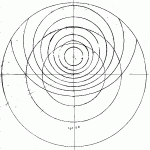Drafting the Astrolabe: 1. Planning the Project
- on 08.17.11
- Astrolabe Project, Drafting The Astrolabe
- No Comments
The first step has to be making myself a protractor. I was going to create one as a proof of concept then switch to a commercial model, but I have changed my mind. If I can make a reasonably accurate tool, I can laminate it and use it; getting rid of the need to ‘cheat’.
I’m tempted to jump right into the climate plates next; but I think that they really need to be much further down the list. The construction of the climates is the most complex and confusing and I will have to lay a lot of groundwork before I am ready to start documenting that process.
My rough schedule is as follows:
- Explain the geometric construction techniques to be used. Number them to allow me to refer to them later.
- Draft the protractor
- Rough out the design for the astrolabe as a whole. I can then use this rough model to transfer measurements from for the various parts.
- The front of the mater:
- time scale
- interior scale
- throne
- The back of the mater:
- zodiac scale
- calendar scale
- unequal hour scale
- shadow scales
- throne
- The climate plates.
- The rete.
- The alidade and rule.
